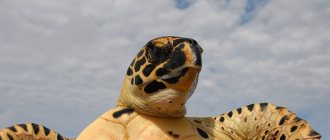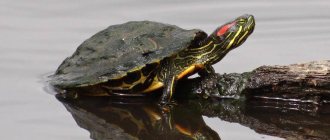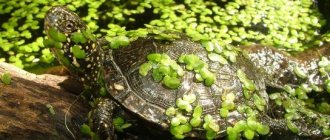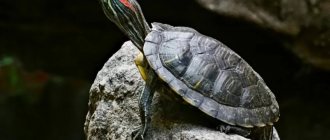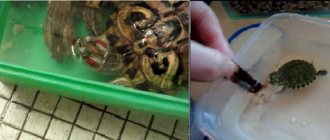Turtles are one of the oldest species of reptiles. These are unique animals that are able to survive in the harshest living conditions. Some species are well adapted to low temperatures, others to high temperatures. Certain subspecies of reptiles can live without food and water for several years, and some can live without oxygen for more than 10 hours. Their size is also striking, which can be a few centimeters or reach 1-2 meters or more.
The ranking shows the largest turtles in the world in terms of size and body weight.
How do turtles lay eggs?
Apparently, the tourists caught the eye of a female who buried her eggs not far from the shore. Such a sight can be seen quite rarely, because representatives of this species of turtles crawl onto land only at night, and during the day they can only be seen during the laying of eggs once every 1-3 years. During the breeding season, females can lay up to 7 clutches with hundreds of eggs, with breaks between laying being approximately 10 days. The depth of the dug nests is at least one meter - the eggs are carefully buried in order to protect them from predators.
Read also: Making Mirror Suits
By the way, in the future, due to global warming, only female turtle eggs will hatch
Hundreds of eggs subsequently hatch into baby turtles, which almost immediately climb out of the nest and crawl towards the water. These tiny creatures then grow into real giants with a body length of up to 2.6 meters and almost the same span of flippers. With all this, the body weight is an impressive 916 kilograms. Whatever one may say, these turtles are still larger than even humans. It is simply impossible to raise such giants without special machines.
Leatherback turtle underwater
Arrau
Arrau or tartaruga is a large representative of the family of pelomedus turtles that inhabit the waters of the Amazon and Orinoco. The weight of an adult is up to 70 kg, and the body length does not exceed 100 cm. Tartaroogs feed exclusively on greens and are characterized by the fact that they can develop incredible speed if they are in danger.
For a long time, Indian tribes hunted these creatures to eat meat, and also destroyed their nests and extracted oil from their eggs. Recently, the population of arrau has decreased significantly, which is why the species is included in the Red Book as being on the verge of extinction. However, although the authorities of South American countries are fighting poaching, the annual collection of eggs in the Amazon region is over 45 million. They are sold on the black market or used as food by the natives.
Common turtle (Macroclemys temminckii)
Read also: How to make a snowman with your own hands
Body length: up to 150 centimeters
The snapping turtle is the only species of turtle in the family Macroclemys. Having met it in the wild, it can easily be confused with the snapping turtle, they are so similar. But the snapping turtle is much larger and has a number of differences. The eyes are located on the sides of the head, and the shell has a series of sawtooth teeth in the form of a single ridge.
The turtle is one of the large turtles. The length of adult individuals reaches 1.5 meters and weight - 60 kg. The freshwater turtle received the nickname “Dinosaur” due to its impressive size and appearance.
The snapping turtle lives in the southeastern regions of the United States. Mainly found in the Mississippi River basin.
The main food is fish. Hunt a turtle in an original way. It burrows into the bottom silt of a reservoir and motionlessly waits for its prey, sticking out only its reddish tongue, which acts as bait.
Taking care of the offspring, the snapping turtle digs a half-meter hole in which it lays its eggs.
3
Setting up a home for a turtle
In order for the new tenant to feel cozy and comfortable with you, you should first of all take care of a comfortable home. An aquaterrarium is the most suitable housing for freshwater reptiles. The red-eared turtle will feel comfortable and cozy in such a container. The size of the aquarium should be sufficient to hold 150–200 liters of water. It must be changed at least once a month, after letting it sit for five days. To keep your aquarium clean, it is advisable to purchase a water filter.
The peculiarities of the existence of a freshwater turtle require the presence of a small piece of land nearby. Artificial islands with gentle banks can be freely purchased at a pet store. It is desirable that the slope has a rough, uneven surface, then the reptile can freely get out onto land.
The turtle loves warmth very much, so it is necessary to arrange an artificial sun for it, which will well illuminate the top of the island and warm the air at its surface to 30-31 oC. To maintain a comfortable water temperature (from 24 to 26 °C), an adjustable incandescent lamp is installed.
It is desirable that the container for keeping reptiles has an elongated rectangular shape. The size of an aquarium for a red-eared turtle with a shell length of 25 cm can have the following approximate indicators:
- volume – 150 l;
- length – 1000 mm;
- width – 500 mm;
- height – 900 mm;
- water depth – 500 mm;
- island length – 250 mm;
- island width – 120 mm.
Despite their deceptive slowness, reptiles are actually very agile. Therefore, when arranging sushi, you should position it so that the distance from the top to the edge of the glass wall is at least 30–35 cm. The proposed container parameters are optimal for one adult red-eared turtle to comfortably fit in it. It is not always possible to maintain the dimensions at home due to lack of free space in the apartment. For comfortable living of two adults, you will need an aquaterrarium with a capacity of at least 180–200 liters.
Spurred turtle
The spur-footed turtle (75 cm) is one of the largest land turtles. The average shell size of this species is 75 cm. There is evidence that the turtle can reach 1 m in shell length. The weight of females is about 60 kg, males - 100 kg. The habitat of amphibian giants is the deserts of Africa. Basically, these are herbivores that can easily go without water for a long time. They grow very quickly and reach the specified sizes by the age of 20. The number of the species has recently been declining due to hunting and habitat destruction. In captivity, turtles can live more than 50 years.
Archelon
The largest sea turtle on the planet, which lived during the Cretaceous period. According to the study of the animal's skeleton, adult individuals weighed over 2 tons, and the span of their front legs reached five meters. The first archelon turtle was found by explorer and archaeologist Weiland in 1896. He managed to discover the skull of a creature 70 cm long in the bowels of the Earth. Later, a complete skeleton of an archelon was found in South Dakota, which helped scientists learn more about this type of prehistoric animal. In the 2000s, paleontologists unearthed several unusual turtle specimens. They were missing 1-2 limbs. Presumably, they were lost in a fight with a mosasaurus.
Vulture
The snapping (alligator) turtle lives in fresh water bodies in America. Most often found in Mississippi and Illinois rivers. It differs from its fellows in its aggressive behavior. If you catch a snapping turtle, whose length reaches 1.5 meters and weighs 60 kg, it will fiercely resist, try to bite the enemy with powerful jaws and release a hissing stream of liquid from the anal glands. These animals are predators and feed mainly on fish. The alligator turtle lowers its head into the pond, sticks out the thin tip of its tongue, reminiscent of a worm, and waits for the fish to grab onto it. Afterwards, she catches the prey with her teeth and chews it.
The shells of all aquatic turtles eventually become covered with algae, which become food for fish.
Miolania
Myolania are extinct creatures from a genus of secretive-necked turtles. They inhabited the territory of Australia and New Caledonia 2 thousand years ago. Upon careful study of the remains of Myolania, found in the 19th century by paleontologists from America, it was found that the length of the turtle from the tip of the muzzle to the tail was about 4.5 meters. On her head were two massive horns, with which she defended herself from natural enemies and dug the ground in search of food. The animal's tail was also studded with bone spines that could pierce the thick skin of the ankylosaur. According to the pattern of discovering the remains of ancient turtles, they lived in dense forest thickets, next to rivers and lakes. Their diet included only plant foods.
Green
Other names for the animal are soup turtle or sea turtle. This type of creature lives in the waters of the world's oceans, preferring tropical and subtropical areas. They are included in the list of the largest turtles on the planet. The length of a mature individual is 1.5 meters, weight – up to 300 kilograms. Animals spend their childhood in the ocean, feeding on algae, small and medium-sized fish, jellyfish and crustaceans. Closer to mid-life, they swim to the shore and go onto land in search of plant food.
Soup green turtles are nicknamed because their meat is very tasty and nutritious, so it is often used in making soups. Despite the fact that catching these creatures is prohibited, in some restaurants around the world you can find them on the menu.
Gigantic
Another name for the giant tortoise is Seychelles. Its length is up to 120 cm, weight ranges from 250-290 kilograms. Representatives of this species live on the island of Aldabra and are considered endemic. Gigantic turtles are listed in the Red Book as a rare species on the verge of extinction. No more than 150 thousand individuals live in the world, some of which were transported to Magadagascar, the islands of Mauritius and Reunion.
Feral goats are a serious competitor to giant tortoises, which has led to a decline in their population. They attack reptiles, breaking their strong shells with their hooves and eating their meat. To protect turtles from extinction, Seychelles authorities shoot goats. To restore the numbers of this species, a special organization was founded, which is located on Aldabar. Its goal is to breed as many young animals as possible in laboratory conditions and help them adapt to the environment.
Vulture turtle
The snapping turtle (140 cm) is similar in appearance to the snapping turtle, but is much larger. The average size of the animal's shell is 140 cm. The species is distributed in the southeastern United States. Their weight is relatively small and reaches 60 kg. Freshwater animals feed mainly on fish. In favorable conditions, some individuals live up to 80 years. The turtle is considered very aggressive, especially the males during the breeding season. If the giant doesn't like something, he can bite. The meat of this species is used to make turtle soup. This is one of the largest but lightest turtles.
Balanced diet
In nature, red-eared turtles feed not only on plant foods, but also on animal foods. Therefore, at home it is very important to organize for them a balanced diet that corresponds to the natural composition. For active growth, turtles require a lot of protein, so they must be fed animal food once a day. Young individuals are given dry fish food, earthworms, bloodworms, woodlice, and sea crustaceans (dried or live).
An adult red-eared turtle, whose size (photo below) exceeds 10-12 cm, can eat liver, raw or boiled beef, and chicken. It is also useful to treat her to raw low-fat fish, squid, and shrimp. You can add several small fish into the aquarium so that the turtle hunts them itself. Various insects (beetles and larvae) should definitely be included in the freshwater menu. For convenience, you can prepare a mixture of several gelatin-based foods with the addition of raw chicken eggs. The finished composition can be stored in the refrigerator for a long time.
As reptiles grow, plant foods should be introduced into their diet. In the aquarium, aquatic plants are bred that the turtle can eat: algae, duckweed, water hyacinth, edogonium, ludwigia and some others. Turtles happily eat fresh greens: mallow, basil, dandelions, clover, peas. For vegetables, you can give pieces of carrots, fresh cucumber, white cabbage, and lettuce. Bone meal is an essential source of calcium, which is required for skeletal growth and shell strengthening. Once a week it should be added to the turtles' food. From time to time it is useful to add a couple of drops of vitamin D oil solution to your food.
If it is not possible to create ideal living conditions for the turtle and organize proper nutrition, you should take care to introduce mineral supplements and vitamin supplements into the diet.
Feeding is carried out during the daytime, since freshwater animals are most active during this period of the day. All food for turtles is simply poured into water. Food must be given little by little so that the animals have time to eat it. Excess food will settle to the bottom and, rotting, pollute the water in the aquarium. Young animals are fed daily, but adults need to be given food 2-3 times a week.
Social structure and reproduction
Photo: Giant turtle from the Red Book
Giant tortoises reach sexual maturity between 20 and 25 years of age, and when the time is right, the male will mount the female and extend his long tail, which contains his penis, under her tail.
The underside of the male shell is convex, so it fits tightly to the rounded dome of the female and does not slip off.
Interesting fact: The male Galapagos tortoise is very noisy, and his distant grunts can be heard at a distance of about 100 meters. Hormone-filled males have been known to pick up stones, mistaking them for willing females. Not surprisingly, there are no records of this behavior producing offspring.
Mating can occur at any time, but usually between February and June. Females travel several kilometers to nesting sites in dry, sandy coastal areas. Using her hind legs, she digs a deep cylindrical hole and lays her eggs. Dome-shaped females dig 2-3 nests per year, 20 eggs per nest. Saddleback females, living in harsher environments, dig 4 to 5 nests per year, averaging 6 eggs per clutch, to spread the risk. In each case, she retains the sperm from 1 copulation and uses it to fertilize several batches of eggs.
Fun fact: Nest temperature determines the sex of the young, with warmer nests producing more females.
After 4-8 months, young individuals emerge from the eggs and dig them to the surface. They remain in warm, low-lying areas for the first 10-15 years. If they survive the initial dangers of extreme heat, crevasses, hungry sailors and Galapagos hawks, they are likely to live to old age.
Written beauty
The literal translation of the name Trachemys scripta from Latin is “lined” or “painted”. The unique beauty of the pattern of the shell, which extends to the head and limbs, attracts the eye of the red-eared turtle. At first glance, its size seems small and makes you want to immediately pick up and place the animal at home.
Indeed, the turtle outfit looks bright and colorful: red oblong spots in the ear area and an intricate pattern of rings on the shell. Some subspecies have yellow or orange spots. The outfit of young individuals is distinguished by rich shades of green, yellow, and brown. With age, the colors of turtles change, losing their original variegation and richness of colors. In old age, a bright pattern may lose its outline and merge into one dark brown or black color.
What does a giant turtle eat?
Photo: Giant turtle on land
Giant tortoises are vegetarians and are known to feed on more than 50 plant species in the Galapagos Islands, including grasses, leaves, lichens and berries. They eat 32 to 36 kg per day, most of which is indigestible. They move slowly and apparently aimlessly, eating what they find.
Getting ready to make a new friend
Before you buy a new tenant, you should think carefully about whether a red-eared turtle is really needed in the house. How big does the animal grow, how much food does it eat, how long does it live? You need to know the exact answer to these and many other questions. It should be understood that the turtle requires special attention and great patience. In the wrong hands, an animal can simply die. Red-eared turtles love affection and are responsive and peaceful. You should not buy a reptile from strangers: attachment to the previous owners can cause melancholy and illness in animals. For choice and advice, it is better to contact specialized stores. There you can get competent advice on keeping and caring for turtles.
If you decide to purchase young animals that are several months old, then remember that at this age they are very susceptible to various diseases. From the first day a young turtle appears, you need to provide it with proper nutrition and vitamin supplements.
Elephant or Galapagos
This is the largest land turtle. This species is distinguished by its longevity. In captivity, they live on average up to 170 years. They are found exclusively on the Galapagos Islands - hence the second name of the species.
Initially there were 15 subspecies of these reptiles. But people killed animals for their delicious meat and for making oil from them. Only 10 subspecies managed to maintain their populations. Of the eleventh subspecies, until 2012 there was only one individual living in captivity. The male who went down in history was given the name Lonesome George.
At the beginning of the 20th century, people began to make efforts to ensure that these huge turtles remained on the planet. A program was developed to incubate reptile eggs and raise young animals. The grown turtles were released into the wild. But today these huge turtles are included in the list of “vulnerable animals on the planet.”
This world's largest land turtle has a large shell, into which it retracts its head and paws when in danger. The light brown carapace is connected to the ribs of the reptile and is part of the skeleton.
Although they often try to determine the age of a reptile by looking at the rings of its shell, this is ineffective in this case. The old layers of the drawing are erased over the years. Therefore, today, to prove that giant tortoises are indeed long-lived, DNA analysis is done.
Giant tortoises feed on plant foods. They happily consume even those plants that are poisonous.
Galapagos tortoises are very peaceful, easily tamed, and even trainable. They respond to a nickname, go out on a signal, and can learn to pull the bell themselves, demanding attention or a treat.
The size and weight of the reptile depends on climatic conditions. In places where humidity is low, these reptiles are much smaller than those that live in less arid areas. They reach only 54 kg in weight.
But under favorable conditions, a real giant turtle can grow. An individual was registered whose carapace length reached 122 cm. This giant turtle weighed 3 quintals.
Leathery
The largest turtle in the world, listed in the Guinness Book of Records. Its length is over 200 cm, and its weight exceeds 550 kilograms. The creature's head is very large and does not retract under the shell, so it is considered a vulnerable spot. The span of the front flippers is up to 550 cm. The dorsal shield of a turtle is a hard but flexible growth with five longitudinal ribs. Young animals have white spots on it, which disappear with age.
This species of turtle is becoming rarer every year. Scientists predict that in a couple of decades it will receive the status of “endangered”. But for now you can see leatherback turtles on the coast of North America, in the waters near Madagascar, Arabia and in the Black Sea. Occasionally they swim to Bermuda and Europe.
List of suitable products
- Beef, turkey, rabbit, chicken. Meat should be periodically subjected to short-term heat treatment, combined with raw meat, otherwise animals may develop rickets.
- Low-fat river fish: cod, carp, bream, pike perch, pollock, hake, sprat.
- Crustaceans, mollusks, squids.
- Liver, heart, stomachs.
- Insects: grasshoppers, earthworms, crickets.
IMPORTANT! It is safer to buy insects from pet stores. In their natural environment, they can be poisoned with chemicals. A poisoned insect is not suitable for food.
- Vitamins, supplements. The diet must contain calcium for proper development of bones and shell. It is added to products in the form of a special powder for reptiles. Due to the lack of calcium, the shell can become deformed or even fall apart in advanced cases.
- Vegetables: zucchini, broccoli, eggplant, bell pepper, grated carrots.
- Greens: meadow grass, lettuce.
- Dried seaweed.
- Aquatic vegetation: duckweed, spirogyra. Algae must be grown separately, otherwise the turtle may overeat on them.


